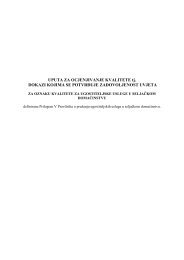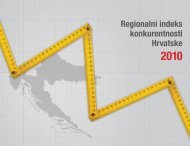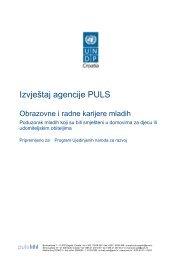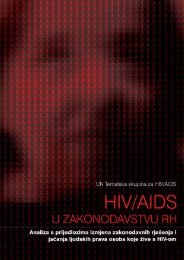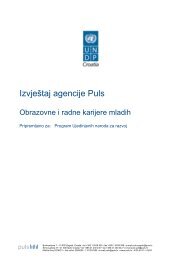WEB engleska verzija end.indd - UNDP Croatia
WEB engleska verzija end.indd - UNDP Croatia
WEB engleska verzija end.indd - UNDP Croatia
- No tags were found...
Create successful ePaper yourself
Turn your PDF publications into a flip-book with our unique Google optimized e-Paper software.
THE SOCIALLY EXCLUDEDCHAPTER 3professional opinion, alcohol-induced disorders are resolvedat the national level according to a public healthmodel, and not according to a clinical-medical model.Unfortunately, the welfare system’s interventions arefew and ineffective and do not have a significant impacton improving the care for alcoholics in a given community.In many cases, <strong>Croatia</strong> has opted for expensiveforms of assistance for alcoholics, with a low efficiencyrate, and a low rate of coverage. This assistance mostlyinvolves hospital detoxification and accommodation ofalcoholics in general psychiatric wards without specificprogrammes targeting their psycho-social recovery.In <strong>Croatia</strong>, there are limited numbers (or none at all) ofspecific programmes designed to assist in the recoveryof alcoholics, day hospitals, week<strong>end</strong> hospitals foralcoholics who undergo treatment while they are maintainingtheir employment, hospital departments, andtherapeutic communities or social homes. The systemthat supports alcoholics’ families, their spouses and childr<strong>end</strong>oes not exist. Thus, it is strategically important tosupport the establishment of new and existing Clubs ofTreated Alcoholics that facilitate recovery based on theself-help principle. Currently there are about 170 Clubsof Treated Alcoholics in <strong>Croatia</strong>. It would be ideal to haveone Club of Treated Alcoholics per 10,000 inhabitants,which would require about 500 of them.Within the socio-cultural framework of <strong>Croatia</strong>, alcoholismis viewed at varying levels of dep<strong>end</strong>ency, basedon the general tolerance of <strong>Croatia</strong>ns for moderate andeven high (but not excessive) levels of consumption.Towards the more tolerated level of dep<strong>end</strong>ency, anindividual may become dep<strong>end</strong>ent on alcohol, but onlyto the extent that the addiction impacts their privatelife. While all forms of alcoholism are dysfunctional, thismight be considered a form of “functional” alcoholism,again, because of <strong>Croatia</strong>’s socio-cultural framework.Most alcoholics – up to three quarters – are considered‘functional’ alcoholics whose drinking is indep<strong>end</strong>entof their multiple social roles (i.e. family, work) and whomostly function normally. Those who consume excessiveamounts of alcohol, to the point where their addictionimpacts their public life, might be considered to be “dysfunctional”alcoholics. Dysfunctional alcoholics accountfor only about 15% of those with drinking problems in<strong>Croatia</strong>, yet they receive the majority of targeted programmes.However, the programmes designed to assistdysfunctional alcoholics are generally not suitable forothers with varying levels of dep<strong>end</strong>ency. These peopleare left with nowhere to turn to for adequate support,advice, or even information. Up to 80% of alcoholics, andthose at risk of becoming alcoholics, are not covered byany sort of organised assistance.The majority of people with alcohol dep<strong>end</strong>encyproblems are relatively easy to treat and even brieftherapeutic interventions by a general practitionermake a significant impact on recovery, preventingprogression towards dysfunctional alcoholism. Throughmotivational interviews and brief focal interventions,functional alcoholics are assisted by engaging in selfhelptechniques. Unfortunately, <strong>Croatia</strong> has no suchservices or interventions.Continuing, supportive, and frequent but low intensitytherapy is the doctors’ method of choice for treating individualsdep<strong>end</strong>ant on alcohol. Consequently, the majorityof alcoholics are treated outside the hospital andin self-help groups. Currently, there are only four groupsof Alcoholics Anonymous and one professionally-runself-help group for women with drinking problems.A coherent state strategy for treating alcohol-relateddisorders would need to incorporate the therapeuticaction provided by self-help groups, derived from (or directlyrelated to) world-renowned self-help movementsfor people with drinking problems. These groups couldinclude inter alia, AA-groups (Alcoholics Anonymous),RR-groups (Rational Recovery), MM-groups (ModerationManagement), and WFS-groups (Women for Sobriety).Most formal support systems for alcoholics are organisedto meet the needs, patterns, and characteristicsof male clients. If women are not successful in maintainingtheir sobriety, it is believed that that they didnot try hard enough, as opposed to the more likelyreason, that they did not receive the proper support.Self-help groups for women with drinking problemscan better address the specific nature of women’sdrinking in a way that is not possible for self-helpgroups that target both g<strong>end</strong>ers.Users of psychoactive drugsCompared with the past decade, the growing tr<strong>end</strong>of treatment for drug users (that began in theearly 1990s) has been halted, making the numberof treated drug users stable since 2000. The totalnumber of treated drug users in the few past yearsranges from 5,400 and 5,700. The number of treatedheroin users ranges from 4,000-4,200 cases, whilethe annual number of reported new heroin users123



